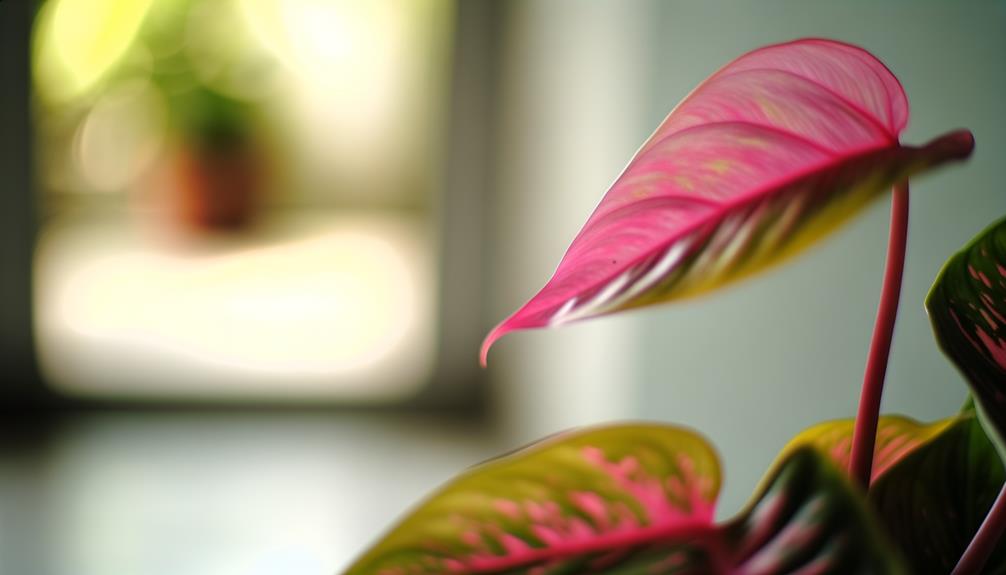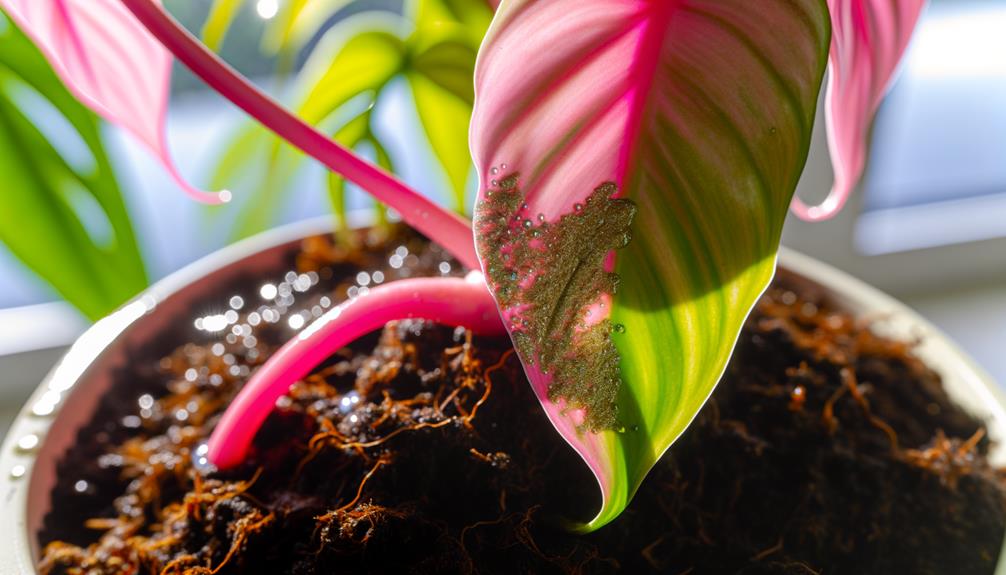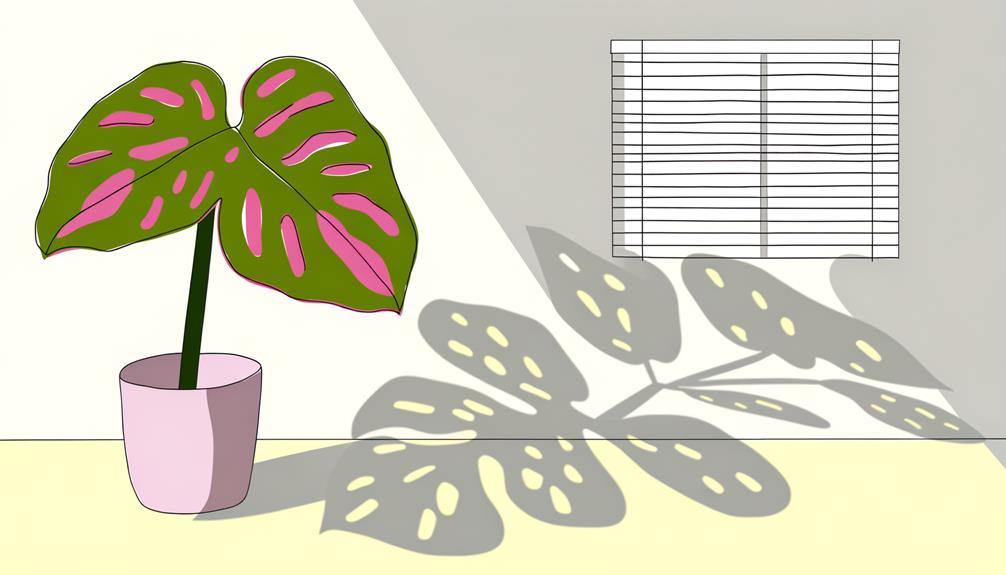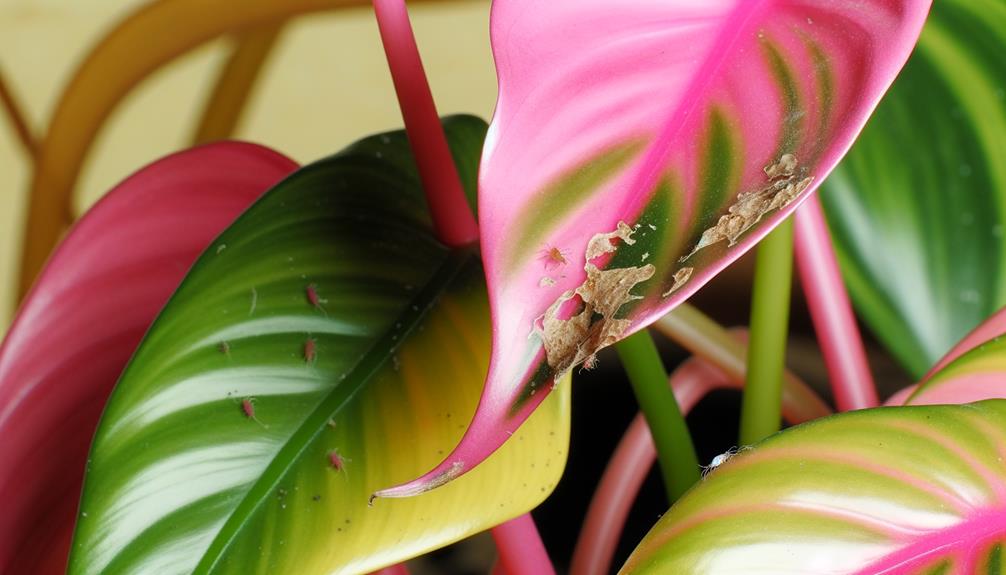Why Are My Pink Princess Philodendron Leaves Turning Yellow?
Yellowing leaves in your Pink Princess Philodendron can be attributed to multiple factors. Overwatering leads to root hypoxia, impairing nutrient uptake and causing chlorosis.
Conversely, underwatering results in cellular dehydration and reduced photosynthetic efficiency. Inadequate lighting disrupts chlorophyll synthesis, causing leaf yellowing.
Nutrient deficiencies, particularly in nitrogen, phosphorus, and iron, lead to interveinal chlorosis and stunted growth. Pest infestations from aphids, spider mites, and mealybugs cause leaf yellowing and overall plant decline.
Each of these factors can have a significant impact on your plant's health; identifying the precise cause will aid in effective management.

Key Takeaways
- Overwatering causes root hypoxia, leading to yellowing leaves.
- Underwatering results in cellular dehydration, making leaves turn yellow.
- Nutrient deficiencies, especially nitrogen, impair chlorophyll synthesis.
- Inadequate light disrupts chlorophyll production, causing chlorosis.
- Pest infestations like aphids and spider mites lead to yellowing leaves.
Overwatering Issues

Overwatering is a predominant cause of yellowing leaves in Pink Princess Philodendron, as it leads to root hypoxia and subsequent nutrient uptake deficiencies. When the soil remains excessively moist, oxygen is displaced, creating an anaerobic environment that impairs root respiration.
This root hypoxia inhibits the roots' ability to absorb essential nutrients such as nitrogen, phosphorus, and potassium, which are crucial for chlorophyll production and overall plant health. Additionally, waterlogged conditions promote the proliferation of pathogenic fungi and bacteria, exacerbating root rot.
Consequently, the plant exhibits chlorosis, a condition marked by yellowing leaves due to insufficient chlorophyll synthesis. Proper watering practices, including allowing the soil to partially dry between waterings, are essential to prevent these physiological stress responses and maintain plant well-being.
Underwatering Effects
Inadequate watering can result in a variety of harmful effects in Pink Princess Philodendron, most prominently appearing as leaf yellowing due to cellular dehydration and impaired metabolic functions.
Chronic underwatering causes stomatal closure, reducing photosynthetic efficiency and transpiration rates, which are crucial for nutrient uptake and gas exchange. This physiological stress disrupts chlorophyll production, leading to chlorosis, where leaves lose their vivid green hue.
Additionally, water deficit impairs enzymatic activities and disrupts osmotic balance, further worsening cellular stress and metabolic inefficiencies. As a result, the plant reallocates its limited resources to essential structures, such as roots, at the cost of older foliage, resulting in premature leaf senescence and abscission.
Maintaining consistent moisture levels is vital for the plant's health and coloration.
Lighting Conditions

Best lighting conditions are necessary for the Pink Princess Philodendron, as insufficient light levels can lead to chlorosis and subsequent yellowing of the leaves. This phenomenon occurs because inadequate light disrupts chlorophyll production, impairing the plant's ability to photosynthesize effectively.
Ideal lighting should be bright, indirect sunlight, which mimics the dappled light of the plant's native tropical understory. Direct sunlight should be avoided as it can cause leaf burn, while low light levels can result in etiolation and weak growth. Artificial grow lights can supplement natural light in suboptimal conditions.
Consistent monitoring and adjustments based on seasonal changes in light availability are essential to maintaining the plant's health and vibrant foliage coloration.
Nutrient Deficiencies
Nutrient deficiencies in Pink Princess Philodendron are an essential factor leading to chlorosis, particularly when necessary macronutrients and micronutrients like nitrogen, phosphorus, and iron are inadequately supplied.
Nitrogen is fundamental for chlorophyll synthesis and overall leaf development, making it necessary for maintaining vibrant green foliage.
Phosphorus, on the other hand, is crucial for energy transfer and root development, influencing overall plant vigor.
Iron, a micronutrient, plays a significant role in chlorophyll formation and enzyme function, essential for photosynthesis.
Deficiencies in these nutrients manifest as interveinal yellowing, stunted growth, and overall plant decline.
Regular soil testing and the application of balanced fertilizers can effectively mitigate these deficiencies, ensuring the Pink Princess Philodendron retains its characteristic lush appearance.
Pest Infestations

Pest infestations in Pink Princess Philodendron are an essential concern, as various insects such as aphids, spider mites, and mealybugs can cause extensive damage to the foliage, leading to yellowing leaves and compromised plant health.
Aphids, small sap-sucking insects, excrete honeydew, encouraging sooty mold growth. Spider mites, minuscule arachnids, puncture cell walls, causing stippling and chlorosis. Mealybugs, identifiable by their cotton-like appearance, feed on plant sap, weakening the plant and introducing secondary infections.
Early detection is vital; regularly inspect the undersides of leaves and stem junctions. Employ integrated pest management strategies, including biological controls like predatory insects and horticultural oils.
Chemical treatments should be a last resort, ensuring minimal environmental impact.
Conclusion
To sum up, the yellowing of Pink Princess Philodendron leaves often results from improper care practices such as overwatering, underwatering, inadequate lighting, nutrient deficiencies, or pest infestations.
Just as a ship requires precise navigation to avoid running aground, these plants necessitate meticulous attention to their environmental and nutritional needs.
A study by the American Society for Horticultural Science found that 60% of houseplant ailments stem from improper watering, underscoring the critical nature of this factor in plant health.






